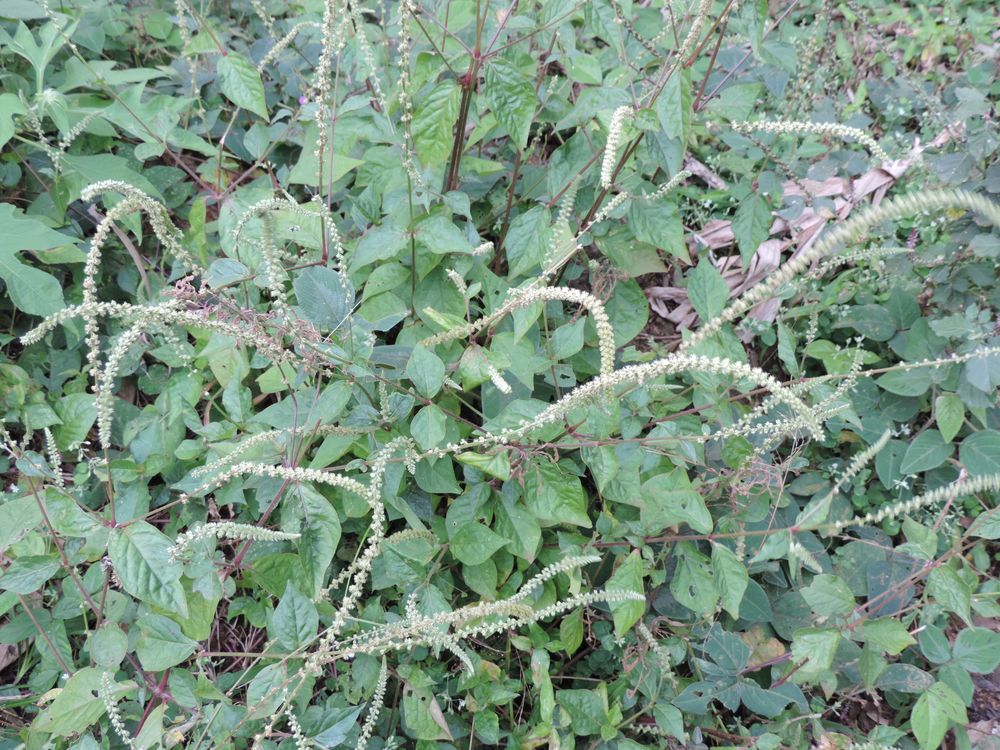Cyathula prostrata

|
|
Cyathula prostrata Common Names: Pasture Weed, Prostrate Pastureweed,
Prostrate Chaff-Flower Species ID: NMP-033 | wfo-0000631218|NCBI_Taxonomy ID: 221766 Scientific
Classification Kingdom: Plantae Clade: Tracheophytes Clade: Angiosperms Clade: Eudicots Order: Caryophyllales Family: Amaranthaceae Genus: Cyathula Species: C. prostrata Binomial Name: Cyathula prostrata (L.) Blume Synonyms: Achyranthes prostrata L., Desmochaeta prostrata (L.) DC., Pupalia prostrata (L.) Mart. Morphological Description Cyathula prostrata is an annual or short-lived perennial herb with prostrate,
ascending, or erect stems, growing 20–60 cm tall, often rooting at nodes. Key
features include: · Stems: Slender, branched, 1–2 mm thick, hairy, green to reddish · Leaves: Lanceolate to elliptic, 2–8 cm long, 1–3 cm wide,
rough-textured, opposite, petiolate (0.5–2 cm) · Flowers: Small, greenish-white, 2–3 mm long, in dense axillary or
terminal spikes (1–3 cm), flowering year-round in tropics · Fruit: Utricles, 1–2 mm, enclosed in persistent perianth, seeds
ovoid, brown Its prostrate habit aids
in soil coverage (Townsend, 1985). Distribution and Habitat Cyathula prostrata is pantropical, spanning Africa (Senegal to Ethiopia, south
to South Africa), Asia (India to Indonesia), Australia, and parts of the
Americas. It thrives in: · Regions: Grasslands, open woodlands, roadsides, disturbed sites · Climate: Tropical/subtropical, 20–35°C, rainfall 500–2,000 mm · Soil: Sandy, loamy, clay; tolerates poor fertility · Elevation: Sea level to 1,800 m It prefers full sun and
is a pioneer species in degraded areas (Burkill, 1985). Ethnopharmacology Cyathula prostrata is widely used in traditional medicine, with studies
validating its applications: · Diuretic: Leaf infusions in Nigeria increase urine output; diuretic
effects. · Anti-inflammatory: Root decoctions in Ghana reduce swelling;
ethanol extracts inhibit edema in mice (45% at 300 mg/kg) (Anaga et al., 2004). · Gastrointestinal Disorders: Whole plant in India treats dysentery. · Wound Healing: Leaf paste in Uganda promotes healing; extracts enhance
collagen in rats. · Antimicrobial: Aerial parts in Nigeria has anti-microbial properties (Ogu
et al., 1970). · Analgesic: Stems in Kenya for pain; extracts reduce writhing in mice
(60% at 200 mg/kg) (Matu & Van Staden, 2003). Phytochemistry Medicinal properties are
linked to bioactive compounds: · Flavonoids: Antioxidant, anti-inflammatory (Falodun et al., 2006) · Alkaloids: Analgesic, diuretic effects · Saponins: Antimicrobial, wound healing · Tannins: Astringent, gastrointestinal aid · Terpenoids: Anti-inflammatory (Anaga et al., 2004) ⚠ Toxicity Profile: No significant toxicity reported; LD₅₀ >
5,000 mg/kg in rats (safe at therapeutic doses). Excessive use may cause mild
GI irritation due to saponins. Avoid in pregnancy due to limited data (Oyedapo
& Amosun, 2014). Additional Uses · Edibility: Young shoots/leaves cooked as a vegetable in Nigeria, India · Soap: Leaf ash in Ghana for saponin-based soap (Burkill, 1985) · Invasive Potential: Outcompetes natives in Australia, Pacific Islands · Fodder: Grazed by livestock in dry seasons References
External Links More Pictures |
|
| Compounds of Cyathula prostrata | |
| References |